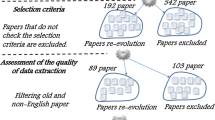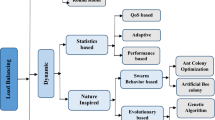Abstract
The introduction of cloud computing has brought about significant developments in information technology. Users can benefit from the multitude of cloud technology services only by connecting to the internet. In cloud computing, load balancing is the fundamental issue that has challenged experts in this research area. Load balancing helps increase user satisfaction and enhance systems’ productivity through efficient and fair work assignments between computing resources. Besides, maintaining a load balancing among resources would be difficult because the resources are usually distributed in a heterogeneous way. Many load-balancing methods try to solve this problem by the metaheuristics algorithm, and each of them attempted to enhance the operation and efficiency of systems. In this paper, Grey wolf optimization (GWO) algorithm has been used based on the resource reliability capability to maintain proper load balancing. In this method, first, the GWO algorithm tries to find the unemployed or busy nodes and, after discovering this node, try to calculate each node’s threshold and fitness function. The results of simulation in CloudSim showed that the costs and response time in the proposed method are less than the other methods, and the obtained solutions are ideal.














Similar content being viewed by others
References
Haji LM, Ahmad OM, Zeebaree SR, Dino HI, Zebari RR, Shukur HM (2020) Impact of cloud computing and internet of things on the future internet. Technol Rep Kansai Univ 62(5):2179–2190
Kumar J, Rani A, Dhurandher SK (2020) Convergence of user and service provider perspectives in mobile cloud computing environment: taxonomy and challenges. Int J Commun Syst 33(18):e4636
Goldberg DW, Bowlick FJ, Stine PE (2021) Virtualization in CyberGIS instruction: lessons learned constructing a private cloud to support development and delivery of a WebGIS course. J Geogr High Educ 45(1):128–154
Sefati S, Abdi M, Ghaffari A (2021) Cluster‐based data transmission scheme in wireless sensor networks using black hole and ant colony algorithms. Int J Commun Syst. https://doi.org/10.1002/dac.4768
Eswari S, Manikandan S Competent data transmission function in cloud computing with high probability aesthetic
Hayyolalam V, Pourghebleh B, Kazem AAP, Ghaffari A (2019) Exploring the state-of-the-art service composition approaches in cloud manufacturing systems to enhance upcoming techniques. Int J Adv Manuf Technol 105(1):471–498
Golchi MM, Saraeian S, Heydari M (2019) A hybrid of firefly and improved particle swarm optimization algorithms for load balancing in cloud environments: performance evaluation. Comput Netw 162:106860
Alicherry M, Lakshman T (2013) Optimizing data access latencies in cloud systems by intelligent virtual machine placement. In: 2013 Proceedings IEEE INFOCOM, 2013. IEEE, pp 647–655
Nurmi D et al. (2009) The eucalyptus open-source cloud-computing system. In: 2009 9th IEEE/ACM International Symposium on Cluster Computing and the Grid, 2009. IEEE, pp 124–131
Zanbouri K, Jafari Navimipour N (2020) A cloud service composition method using a trust-based clustering algorithm and honeybee mating optimization algorithm. Int J Commun Syst 33(5):e4259
Sefati S, Navimipour NJ (2021) A QoS-aware service composition mechanism in the Internet of things using a hidden Markov model-based optimization algorithm. IEEE Internet Things J. https://doi.org/10.1109/JIOT.2021.3074499
Tikhamarine Y, Souag-Gamane D, Ahmed AN, Kisi O, El-Shafie A (2020) Improving artificial intelligence models accuracy for monthly streamflow forecasting using grey Wolf optimization (GWO) algorithm. J Hydrol 582:124435
Kruekaew B, Kimpan W (2020) Enhancing of artificial bee colony algorithm for virtual machine scheduling and load balancing problem in cloud computing. Int J Comput Intell Syst 13(1):496–510
Devaraj AFS, Elhoseny M, Dhanasekaran S, Lydia EL, Shankar K (2020) Hybridization of firefly and Improved multi-objective particle swarm optimization algorithm for energy efficient load balancing in cloud computing environments. J Parallel Distrib Comput 142:36–45
Lilhore UK, Simaiya S, Maheshwari S, Manhar A, Kumar S Cloud performance evaluation: hybrid load balancing model based on modified particle swarm optimization and improved metaheuristic firefly algorithms
Kokilavani T, Amalarethinam DG (2011) Load balanced min-min algorithm for static meta-task scheduling in grid computing. Int J Comput Appl 20(2):43–49
Goyal SK, Singh M (2012) Adaptive and dynamic load balancing in grid using ant colony optimization. Int J Eng Technol 4(4):167–174
Makasarwala HA, Hazari P (2016) Using genetic algorithm for load balancing in cloud computing. In: 2016 8th International Conference on Electronics, Computers and Artificial Intelligence (ECAI), 2016. IEEE, pp 1–6
Garg SK, Yeo CS, Anandasivam A, Buyya R (2011) Environment-conscious scheduling of HPC applications on distributed cloud-oriented data centers. J Parallel Distrib Comput 71(6):732–749
Buyya R, Yeo CS, Venugopal S, Broberg J, Brandic I (2009) Cloud computing and emerging IT platforms: vision, hype, and reality for delivering computing as the 5th utility. Futur Gener Comput Syst 25(6):599–616
Kashyap D, Viradiya J (2014) A survey of various load balancing algorithms in cloud computing. Int J Sci Technol Res 3(11):115–119
Smimite O, Afdel K (2020) Containers placement and migration on cloud system. arXiv:2007.08695
Hao F, Lakshman T, Mukherjee S, Song H (2009) Enhancing dynamic cloud-based services using network virtualization. In: Proceedings of the 1st ACM Workshop on Virtualized Infrastructure Systems and Architectures, 2009, pp 37–44
Dillon T, Wu C, Chang E (2010) Cloud computing: issues and challenges. In: 2010 24th IEEE International Conference on Advanced Information Networking and Applications, 2010. IEEE, pp 27–33
Bari MF, Zhani MF, Zhang Q, Ahmed R, Boutaba R (2014) CQNCR: optimal VM migration planning in cloud data centers. In: 2014 IFIP Networking Conference, 2014. IEEE, pp 1–9
Ashouraei M, Khezr SN, Benlamri R, Navimipour NJ (2018) A new SLA-aware load balancing method in the cloud using an improved parallel task scheduling algorithm. In: 2018 IEEE 6th International Conference on Future Internet of Things and Cloud (FiCloud), 2018. IEEE, pp 71–76
Ghobaei-Arani M, Rahmanian AA, Souri A, Rahmani AM (2018) A moth-flame optimization algorithm for web service composition in cloud computing: simulation and verification. Softw Pract Exp 48(10):1865–1892
Mirjalili S, Mirjalili SM, Lewis A (2014) Grey wolf optimizer. Adv Eng Softw 69:46–61
Betka A, Terki N, Toumi A, Dahmani H (2020) Grey wolf optimizer-based learning automata for solving block matching problem. SIViP 14(2):285–293
Mishra SK, Sahoo B, Parida PP (2020) Load balancing in cloud computing: a big picture. J King Saud Univ Comput Inf Sci 32(2):149–158
Siddiqi MH, Alruwaili M, Ali A, Haider SF, Ali F, Iqbal M (2020) Dynamic priority-based efficient resource allocation and computing framework for vehicular multimedia cloud computing. IEEE Access 8:81080–81089
Author information
Authors and Affiliations
Corresponding author
Additional information
Publisher's Note
Springer Nature remains neutral with regard to jurisdictional claims in published maps and institutional affiliations.
Rights and permissions
About this article
Cite this article
Sefati, S., Mousavinasab, M. & Zareh Farkhady, R. Load balancing in cloud computing environment using the Grey wolf optimization algorithm based on the reliability: performance evaluation. J Supercomput 78, 18–42 (2022). https://doi.org/10.1007/s11227-021-03810-8
Accepted:
Published:
Issue Date:
DOI: https://doi.org/10.1007/s11227-021-03810-8




